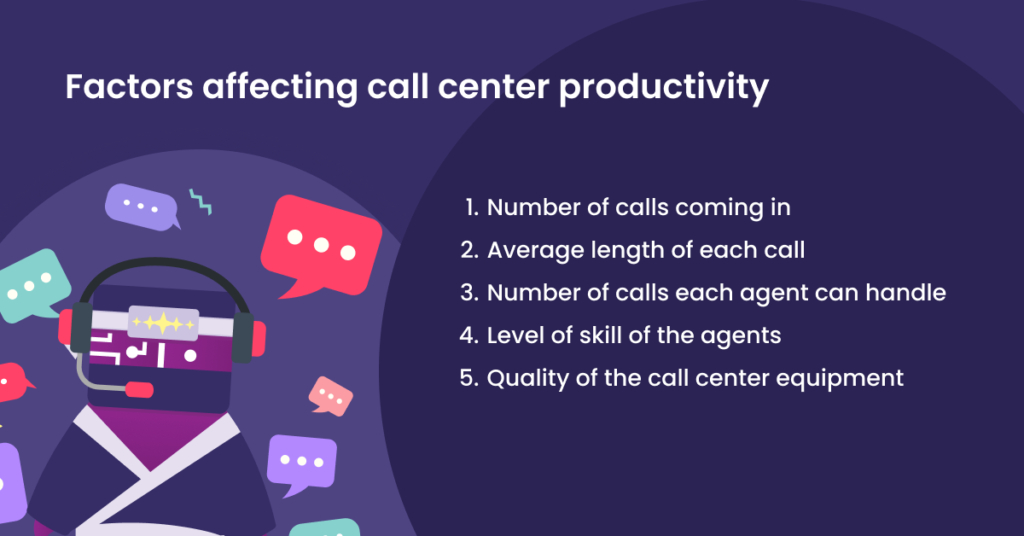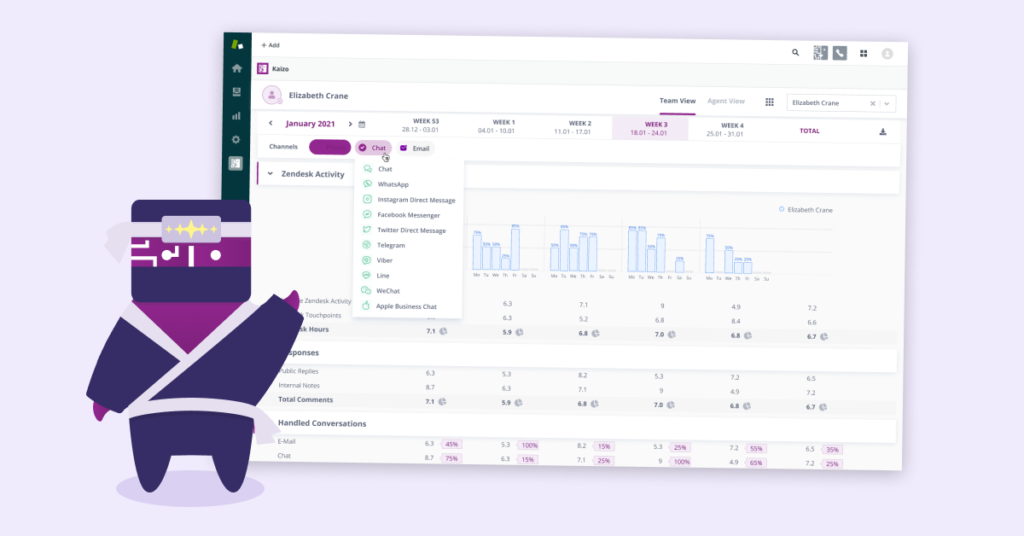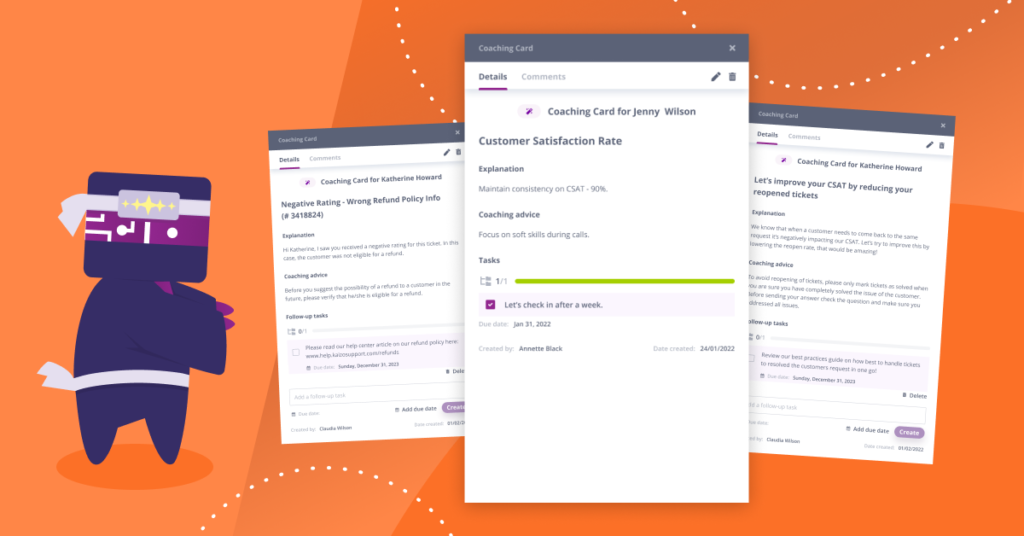When call center employees are happy and satisfied with their job, they’re more engaged, more productive and they provide better service to customers. That’s why it’s so important to boost call center productivity in a recession — when employee happiness isn’t as much of a priority.
The global economy is struggling and most likely, your business is feeling the pressure. The news of layoffs and budget cuts are on our feeds every other day and the possibility that we are heading toward a recession is ever-looming.
However, even though the world is facing challenging markets — businesses can still achieve their goals with existing teams (even if you have to scale down or can’t afford to hire new people). The trick is to use your resources right.
But first, let’s drill into the very meaning of call center productivity and ways you can give it a push with little to no extra expenses.
What is call center productivity?
In simple terms, it measures how effectively a call center handles customer calls and inquiries.
You can measure productivity in many ways. For example, by tracking the average number of calls answered over the number of calls received. The main reason for this KPI to exist is to improve the number of calls a center can handle; it is often measured along with the quality of customer service at the center.
Several factors can affect call center productivity — here are some of them:

Why is it important to track call center productivity?
In call centers, ignorance is not bliss. Quite the opposite. Without an effective solution for tracking call center productivity metrics, managers and agents alike will be completely in the dark.
The goal of tracking productivity is not to work agents to the bone. Yes, call center productivity is based on an agent’s actions but the point is not to punish agents for doing their job.
Managers are interested in productivity because it’s their job to know what resources are needed and where. Particularly, in times of economic strain, it’s important to keep an eye on these metrics because it shows which teams need support and where costs can be cut without disruption.
Outcomes of tracking call center productivity:
- Ensure quick service to customers
- Identify bottlenecks
- Optimize workforce planning
- Monitor long-term trends in call center productivity
- Allocate resources appropriately
- Prioritize budget with data-driven insights
How to calculate agent productivity in a call center?
Normally, productivity in financial terms is
(revenue – cost) / cost
But in a call center, it is slightly different.
So, how do you do the math here?
Well, it is pretty similar to the formula above but you need to do a little tweaking.
Call center productivity formula:
(calls answered / calls received)
For example, if a call center receives 100 calls per hour and agents answer 80 calls, the productivity call center ratio would be 80%.
productivity = (80 / 100)
productivity = 0.8
If you have a lot of agents, you need to add all your agent productivity values and get an average in your overall call center productivity formula.
Top 8 metrics to track agent productivity
First Call Resolution (FCR)
First Call Resolution= (Number of Resolved Calls on First Contact / Total Number of Calls) X 100
First Call Resolution is a metric that measures the percentage of calls resolved upon the first contact. This metric is important to track because it indicates whether agents can resolve customer issues effectively without having to arrange another interaction.
Average Handle Time (AHT)
Average Handle Time = (Total Talk Time + After Call Work Time) / Total Number of Calls
Average Handle Time is a metric that measures the average amount of time it takes for an agent to handle a customer call from start to finish. This metric is important to track because it can indicate how efficiently agents are working. As a rule, there is an AHT per call that agents need to achieve.
Customer Satisfaction (CSAT)
CSAT = (Number of Satisfied Customers / Number of Customers Who Rated) X 100
Customer satisfaction is a metric that measures how satisfied customers are with a product or service they receive. Among other metrics, this one is critical to track because it directly reflects the quality of service. It is different from the NPS because the latter measures the probability of a customer recommending a product or service to a friend or family member.
Abandon Rate
Abandonment Rate = (Number of Abandoned Calls / Total Number of Incoming Calls) X 100
Abandon Rate is the percentage of calls that are abandoned by customers before they are answered by an agent. Abandon Rate is important to track because it can also give you an indication of how efficiently agents are working. Overall, the most important thing to track when trying to improve productivity is customer experience.
Agent Occupancy
Occupancy Rate = (Total Handle Time / Total Available Time) X 100
Agent Occupancy is the percentage of time that agents are on calls. This metric is critical to track because it can indicate how effectively agents use their time. The more is usually the better, but you need to be careful with burnout and allocation of time for off-call. Tools like Scorecards are great for managing all customer service metrics in a matter of a few clicks.
Average Time in Queue
Average Time In Queue = Total Wait Time / Total Number of Calls
Average Time in Queue is a good metric to keep your eye on. When someone calls the support line the caller wants to have their ticket picked up as soon as possible. Waiting a minute for a representative is one thing, but spending 30 minutes can seriously turn off customers in need. 66% of American consumers report that long-wait times are highly annoying when they are looking for support.
Percentage of Calls Blocked
Percentage of Blocked Calls = (Number of Blocked Calls / Total Number of Calls) X 100
Percentage of Calls Blocked can track how often customers hear the “busy tone” after calling customer support. Customers may receive this tone when all agents are busy and the queue is full. This number should stay as low as possible. When your teams are strapped for time and call volumes are high, it’s easy to go blind to overflowing inboxes. However, leaving customers in the dark is the first indicator that managers need to re-strategize agent productivity workflow.
Cost Per Call
Cost Per Call = (Total Operating Costs + Labor Expenses of the Business) / Number of Calls
Cost per call is our last but most important metric. As a matter of fact, Cost Per Call is a key performance indicator and will point to the misuse of time and resources with great accuracy. Team leads, when going into your meetings with upper management, be sure to have this information in your back pocket.
Common mistakes when calculating call center productivity
Before you start working with your data, there are a few common mistakes we want to know about. Calculating metrics is all fine and dandy, but if you don’t know how to read your dashboards or what goals you’re working toward – you might be wasting time.
Here’s a good place to start.
Have you defined your productivity goals yet?
Not defining productivity is a mistake. When you collect metrics, you have to know what you are tracking and why. Defining what productivity for your call center also defines your “why”.
Simply put, you need to have a clear meaning of call center productivity – one that aligns with your customers values and company standards.
If your call center handles time-sensitive requests, First Call Resolution may be a leading indicator of high productivity. But if your customers rather require special individualized attention, say in the form of live or recorded video support, Agent Occupancy may tell you more about the level of agent productivity.
Do you know what your metrics mean?
There’s no use in collecting metrics if you don’t know what they mean. We understand that a high CSAT means customers are happy and a low Cost Per Call means you allocate the budget well. But don’t be fooled. Not every metric is so straightforward.
For example, we want to avoid low Average Handling Times but seeing that number soar isn’t necessarily your agent’s fault. In this case, if you’re also seeing a high percentage of calls blocked, perhaps your software cannot handle the volume of calls.
The necessary action here is to evaluate your management software to understand if your existing solution is solving the pain points you have today.
Another mistake that is frequently made by CS professionals is drawing the wrong conclusion about Agent Occupancy. Yes, when your average Agent Occupancy Rate is high it could mean your agents are being unproductive. On the other hand, it could be mismanagement of workforce planning or simply, that call volume has slowly decreased.
How to improve call center productivity?
1. Use your resources efficiently
One of the biggest productivity killers in a call center is having too few or too many staff.
Having the wrong amount of staff levels can lead to long wait times for customers and frustrated and overworked employees. To avoid this, make sure you have the correct number of agents for the volume of calls you receive.
According to McKinsey, it’s getting harder to hire the right people. For this reason, your HR department, although indirectly, has a great impact on how you improve agent productivity in call centers.
However, it is not just about having more customer service representatives but about knowing how to ensure customer service efficiency. Are you sure your agents are not wasting their time on tasks that could be automated? Do you have a tool to do all metric-related calculations or do you still rely on Excel to eat away at your productivity time?
Be sure to find a system to help you calculate and keep track of your employee performance.
2. Track numbers
By tracking data in call centers, businesses can spot learning opportunities, improve customer experience, and increase sales.
There are a few key data points that you should track when it comes to call centers
- Number of calls received
- Call wait time
- Average Handle Time
- Abandonment Rate
- Customer Satisfaction score
Kaizo’s Scorecards can help you monitor your customer service representative’s activities with 50+ real-time metrics. This system can give you an overview of how many calls representatives make, how long each call lasts, what the customer’s issue is, and whether it gets resolved.
Additionally, you can use this system to evaluate your team performance. This way, you can identify which agents excel and who may need additional training.

3. Identify areas for improvement
Coachable opportunities are everywhere. You need to know how to pinpoint for them.
With Coaching Cards from Kaizo, you can take advantage of these opportunities to learn and grow as a team. Each card features a different activity, question, or task to help you and your team learn from every success and failure. Using these cards, you can create a learning culture in your organization, one that will help you achieve your goals.

4. Cut manual work
To survive a recession, businesses need to be as productive as possible. For call centers, this means automating tasks whenever possible.
There are many ways to automate call center tasks. One way is to use an AI-powered chatbot. Chatbots can handle simple customer queries, freeing human agents to deal with more complex issues.
Another way to automate call center tasks is to use an automatic call distribution (ACD) system. ACD systems route calls to the most appropriate agent based on criteria such as skillset and availability. A well-set system ensures that calls are handled efficiently and reduces customer wait times.
Finally, you need a single platform to review and improve the quality of service your agents deliver. This would be the place where you store ticket data, can view metrics, spot areas for improvement and use them to give agents actionable advice on where, how, and why they should improve.
5. Incentivise agents
One way to increase agent productivity is to use performance management tools combined with incentives.
In other words, you’d have to focus on goal setting, feedback and coaching, measurement, and analysis. You reward your agents by effectively increasing the results of call center productivity calculation. Additionally, having an incentive system in place can help improve agent productivity.
For example, an incentive system can reward agents for meeting or exceeding performance goals. Rewards can vary from vacation days to personalized items or store coupons.
According to Forbes, some of the best practices when trying to increase your call center productivity are:
- create a sense of purpose and connection
- match rewards with positive business behaviors and results
- don’t use incentives as patches to cover up other issues
- make sure employees value incentives
- ask your agents what motivates them
- create versatile incentive systems
- don’t take incentives away once given
For more ideas, check 14+ tips for rewarding employees for great customer service.
6. Leverage technology
To leverage technology to increase agent call center productivity, consider automating processes where possible. Automation can help eliminate error-prone tasks and allow agents to focus on more value-added activities.
Empower agents with the ability to self-manage their performance through regular check-ins and goal setting. By taking some of these steps, you can ensure that your call center is maximizing its use of technology to boost agent productivity.
Making things fun has more impact on productivity than you would think, according to Forbes. This is the very reason why Kaizo leverages gamification — it is a great way to keep people engaged at their work. In fact, Zippia statistics show that 72% of people say that introducing gamification into the workplace motivated them to do tasks and work harder.
By adding a level of challenge and competition to mundane tasks, Kaizo’s gamification can help employees stay focused and motivated.
There are also many ways AI can improve employee productivity. For example:
- AI can help employees manage their time and tasks more efficiently.
- It can provide employees with valuable insights and recommendations to help them be more productive.
- AI can automate specific tasks and processes that would otherwise take up employees’ time and energy.
7. Listen to agent feedback
Typically, it’s not your agents causing long-term productivity issues. Outdated tech, clunky operational processes, common product bugs — agents have seen it all. Better yet, agents will be the first out of every person in the call center to see room for improvement.
In a recession, there’s no room for waste. Agents are a business’s most valuable resource so give them a chance to speak truth to power. By holding operation feedback sessions you’ll have an opportunity to know exactly what needs to be optimized to improve call center productivity. This is also an opportunity to share what KPIs look like in the face of the economic downturn. You may be surprised at how many valuable suggestions your agents have!
8. Eliminate avoidable calls
Speaking of asking for agent feedback – if there is one thing that agents know best, it’s the issues customers face. Every customer is unique and should receive personalized service. However, there’s nothing stronger than the bond of customers’ complaints.
It’s incredibly normal for call centers to hear the same complaints again and again. However, when you want to increase agent productivity – and reduce agent irritation – creating a page for Frequently Asked Questions (FAQ page) is your best bet! FAQ pages are a type of self-service support channel that customers are directed towards when faced with a simple question. Self-service channels are easy and affordable time savers! With an FAQ page, populated by your agent’s help, you’ll see CSAT increase, FCR time drop, and Cost Per Call fall in no time!
Are you ready to start boosting productivity in your teams?



